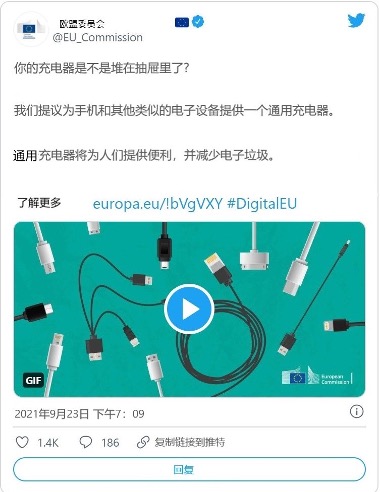欧洲试图统一充电接口,苹果拦路
这次,欧盟(European Union)试图通过立法再次敦促苹果公司(Apple)在iPhone上采用USB-C标准接口。
欧盟委员会(European Commission)于9月23日提议,采用具备快速充电能力的USB-C接口,“作为所有智能手机、平板电脑、相机、耳机、便携式扬声器和手持视频游戏机的标准接口”。欧盟委员会表示,这项法令不涉及无线充电,因为“这是一项仍在发展、市场分化程度较低的技术。”
这项法令还提及,如果业界提出了一种新的有线充电技术,该规定将随时更改,以“确保使用的技术不会过时”。USB-C接口已经广泛应用于移动设备,尽管它的前身micro-USB接口在许多低端手机和小设备中也有使用。
欧盟的数字(以及反垄断)主管玛格丽特·维斯塔格说:“长期以来,欧洲消费者一直对抽屉里堆积的不兼容充电器感到沮丧。我们给了业界足够的时间来想他们的解决方案,现在为统一通用充电器采取立法行动的时机已经成熟。这对我们的消费者和环境来说是一个重要的胜利,展示了我们推动环保绿色和数字化的抱负。”

尽管没有提及苹果的名字,但苹果显然是这项措施的主要目标。苹果公司在很多设备上都采用了现在无处不在的USB-C标准,包括MacBook系列和iPad Pro,但它仍然固执地坚持为iPhone和许多iPad使用其专有的闪电(Lightening)充电器。苹果对闪电充电器和周边设备收取了很高的价格,而且还通过向iPhone和iPad配件的其他制造商授权技术来赚钱。
经久不衰的传奇
欧盟为推动移动设备充电器推动采用统一标准接口已经付出了很长时间的努力,除了苹果之外,该行动实际上是相当成功的。
十多年前,手机充电器大约有30种类型——现在只有三种——欧盟委员会让苹果、诺基亚(Nokia)、三星(Samsung)和其他公司承诺“在USB-C的前身——micro-USB连接器的基础上提供兼容充电器”。大多数业内人士通过在手机上安装micro-USB接口来遵守协议,但苹果利用了协议中的一个漏洞,只提供了一个适配器,让micro-USB充电器可以连接到其专有端口。当然,适配器需要额外收费。
欧盟委员会与制造商之间的谅解协议于2012年到期,之后,包括苹果在内的一些公司签署了“意向书”,表示它们将继续遵守谅解协议的条款。Micro-USB逐渐被更快、更容易插入的USB-C接口所取代,后者于2014年推出。但苹果仍然没有放弃其专利充电器。2018年,在欧洲议会(European Parliament)成员的压力下,维斯塔格宣布了一项影响评估,对强制使用统一充电接口的成本和收益进行评估。
经过对该计划的三次影响评估后,委员会终于提出了一项法令来解决这个问题。
这项法令在本质上是为了保护环境。欧盟委员会在9月23日表示,该提案将每年减少近千吨电子垃圾。这是因为它将把充电器的销售与移动设备本身的销售“分开”——这实际上是苹果领先的一个领域,因为它去年停止在新款iPhone上附带充电器。
“根据我们的提议,欧洲消费者将能够为他们所有的便携式电子产品使用一个统一的充电器——这是增加方便性和减少浪费的重要一步。”内部市场专员蒂埃里·布雷顿在9月23日如此表示。
如果该委员会的提案通过立法程序,它将有两年的执行期,这意味着新规则可能会在2024年生效。苹果称这个时间太短了。
苹果公司在一份声明中称:“苹果公司代表着创新力,并且我们非常关心用户体验。我们仍然担心,要求统一充电接口的严格规定只会扼杀创造力,而不是鼓励技术创新,这反过来会损害欧洲和世界各地的消费者的利益。”(财富中文网)
编译:於欣
这次,欧盟(European Union)试图通过立法再次敦促苹果公司(Apple)在iPhone上采用USB-C标准接口。
欧盟委员会(European Commission)于9月23日提议,采用具备快速充电能力的USB-C接口,“作为所有智能手机、平板电脑、相机、耳机、便携式扬声器和手持视频游戏机的标准接口”。欧盟委员会表示,这项法令不涉及无线充电,因为“这是一项仍在发展、市场分化程度较低的技术。”
这项法令还提及,如果业界提出了一种新的有线充电技术,该规定将随时更改,以“确保使用的技术不会过时”。USB-C接口已经广泛应用于移动设备,尽管它的前身micro-USB接口在许多低端手机和小设备中也有使用。
欧盟的数字(以及反垄断)主管玛格丽特·维斯塔格说:“长期以来,欧洲消费者一直对抽屉里堆积的不兼容充电器感到沮丧。我们给了业界足够的时间来想他们的解决方案,现在为统一通用充电器采取立法行动的时机已经成熟。这对我们的消费者和环境来说是一个重要的胜利,展示了我们推动环保绿色和数字化的抱负。”
尽管没有提及苹果的名字,但苹果显然是这项措施的主要目标。苹果公司在很多设备上都采用了现在无处不在的USB-C标准,包括MacBook系列和iPad Pro,但它仍然固执地坚持为iPhone和许多iPad使用其专有的闪电(Lightening)充电器。苹果对闪电充电器和周边设备收取了很高的价格,而且还通过向iPhone和iPad配件的其他制造商授权技术来赚钱。
经久不衰的传奇
欧盟为推动移动设备充电器推动采用统一标准接口已经付出了很长时间的努力,除了苹果之外,该行动实际上是相当成功的。
十多年前,手机充电器大约有30种类型——现在只有三种——欧盟委员会让苹果、诺基亚(Nokia)、三星(Samsung)和其他公司承诺“在USB-C的前身——micro-USB连接器的基础上提供兼容充电器”。大多数业内人士通过在手机上安装micro-USB接口来遵守协议,但苹果利用了协议中的一个漏洞,只提供了一个适配器,让micro-USB充电器可以连接到其专有端口。当然,适配器需要额外收费。
欧盟委员会与制造商之间的谅解协议于2012年到期,之后,包括苹果在内的一些公司签署了“意向书”,表示它们将继续遵守谅解协议的条款。Micro-USB逐渐被更快、更容易插入的USB-C接口所取代,后者于2014年推出。但苹果仍然没有放弃其专利充电器。2018年,在欧洲议会(European Parliament)成员的压力下,维斯塔格宣布了一项影响评估,对强制使用统一充电接口的成本和收益进行评估。
经过对该计划的三次影响评估后,委员会终于提出了一项法令来解决这个问题。
这项法令在本质上是为了保护环境。欧盟委员会在9月23日表示,该提案将每年减少近千吨电子垃圾。这是因为它将把充电器的销售与移动设备本身的销售“分开”——这实际上是苹果领先的一个领域,因为它去年停止在新款iPhone上附带充电器。
“根据我们的提议,欧洲消费者将能够为他们所有的便携式电子产品使用一个统一的充电器——这是增加方便性和减少浪费的重要一步。”内部市场专员蒂埃里·布雷顿在9月23日如此表示。
如果该委员会的提案通过立法程序,它将有两年的执行期,这意味着新规则可能会在2024年生效。苹果称这个时间太短了。
苹果公司在一份声明中称:“苹果公司代表着创新力,并且我们非常关心用户体验。我们仍然担心,要求统一充电接口的严格规定只会扼杀创造力,而不是鼓励技术创新,这反过来会损害欧洲和世界各地的消费者的利益。”(财富中文网)
编译:於欣
The European Union is making another push to force Apple to adopt the USB-C standard in its iPhones, this time using legislation.
The European Commission on September 23 proposed making USB-C, with fast-charging capabilities, "the standard port for all smartphones, tablets, cameras, headphones, portable speakers and handheld videogame consoles." Wireless charging would not be included in this legal change, the Commission said, as this "is still a developing technology with a low level of market fragmentation."
If industry comes up with a new wired charging technology, it added, the law could be revised to "ensure that the technology used is not outdated." USB-C is already widely used in mobile devices, though its predecessor, micro-USB, is also still found in many lower-end phones and gadgets.
“European consumers were frustrated long enough about incompatible chargers piling up in their drawers," said the EU's digital (and antitrust) chief, Margrethe Vestager. "We gave industry plenty of time to come up with their own solutions, now time is ripe for legislative action for a common charger. This is an important win for our consumers and environment and in line with our green and digital ambitions."
Although the name went unmentioned, Apple is clearly a primary target of the measure. The company has adopted the now-ubiquitous USB-C standard for many of its devices, including the MacBook lineup and the iPad Pro, but it is stubbornly sticking to its proprietary Lightning charger for the iPhone and many iPads. Apple charges a great deal for its Lightning chargers and peripherals, and it also makes money from licensing the technology to other makers of iPhone and iPad accessories.
Long-running saga
The EU's drive to standardize mobile-device chargers has a long history, and—Apple aside—it's actually been pretty successful.
A dozen years ago, at a time when there were around 30 charger types out there for mobile phones—these days it's three—the Commission got Apple, Nokia, Samsung and others to commit to "provide [charger] compatibility on the basis of the micro-USB connector," the predecessor to USB-C. Most of the industry complied by putting micro-USB ports in their phones, but Apple exploited a loophole in the agreement by only providing an adapter so micro-USB chargers could connect to its proprietary ports. Naturally, it charged extra for the adapter.
The memorandum of understanding between the Commission and the manufacturers expired in 2012, after which some of the companies—Apple included—signed "letters of intent" that said they would keep sticking to the MoU's terms. Micro-USB gradually gave way to the faster, easier-to-insert USB-C, which was introduced in 2014. But Apple still didn't drop its proprietary chargers and in 2018, under pressure from members of the European Parliament, Vestager announced an impact assessment into the costs and benefits of moving beyond the voluntary approach to the problem.
Three impact assessments later, the Commission has now finally proposed a law to fix the issue.
The push is partly environmental in nature; the Commission said on September 23 that its proposal would cut nearly a thousand tons of electronic waste each year. That's because it would "unbundle" the sale of chargers from that of the mobile devices themselves—this is actually one area where Apple is ahead of the game, as it stopped including chargers with new iPhones last year.
"With our proposal, European consumers will be able to use a single charger for all their portable electronics—an important step to increase convenience and reduce waste," said Thierry Breton, the internal market commissioner, on September 23.
If the Commission's proposal passes through the legislative process, it would have an implementation period of two years, meaning the new rules would likely come into effect in 2024. Apple claims this is too short.
"Apple stands for innovation and deeply cares about the customer experience," it said in a statement. "We remain concerned that strict regulation mandating just one type of connector stifles innovation rather than encouraging it, which in turn will harm consumers in Europe and around the world."













